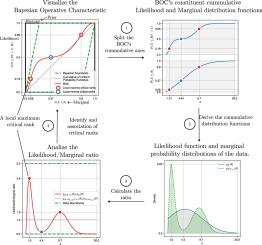贝叶斯运行特征曲线在城市土地覆盖变化特征分析中的应用
IF 4.6
2区 环境科学与生态学
Q1 COMPUTER SCIENCE, INTERDISCIPLINARY APPLICATIONS
引用次数: 0
摘要
总工作特征曲线(TOC)是一种用于评估二元分类器性能的可视化工具,作为对接收者工作特征(ROC)曲线的改进而引入。TOC提供了一个函数,该函数将命中数加上假警报(True positive和false positive)映射为命中数(True positive)。尽管TOC在模型评估中被广泛采用,特别是在土地利用变化研究中,但TOC在解释分类器和数据分布的概率性能方面的数学特性仍未得到充分探索。为了填补这一空白,本文引入了贝叶斯操作特征(BOC)曲线,这是一个新的解释框架,它是应用贝叶斯定理和对TOC曲线的数值分析而得到的。该框架建立了累积和密度分布函数的计算,用来描述和识别秩变量与其二元结果之间的非线性关系,指定在分类中具有最大正影响或负影响的秩区间。通过对城市土地变化驱动因素的分析和识别,揭示了等级变量与二元结果之间不同的非线性概率关系。本文章由计算机程序翻译,如有差异,请以英文原文为准。

The Bayesian operating characteristic curve for feature analysis applied to urban land cover change
The Total Operating Characteristic curve (TOC) is a visual tool used to assess the performance of binary classifiers, introduced as an improvement over the Receiver Operating Characteristic (ROC) curve. The TOC provides a function that maps the number of hits plus false alarms (True Positives and False Positives) to hits (True Positives). Despite its broad adoption in model evaluation, especially for land use change studies, the TOC’s mathematical properties for explaining the probabilistic performance of classifiers and data distributions remain underexplored. To fill this gap, this article introduces the Bayesian Operating Characteristic (BOC) curve, a novel explanatory framework derived from the application of Bayes’ theorem and numerical analysis on the TOC curve. Such a framework establishes the computation of cumulative and density distribution functions that describe and identify non-linear relations between a rank variable and its binary outcome, specifying the rank’s interval with the maximal positive or negative impact in the classification. The proposal is validated by the analysis and identification of urban land change drivers, revealing different non-linear probabilistic relationships between rank variables and the binary outcome.
求助全文
通过发布文献求助,成功后即可免费获取论文全文。
去求助
来源期刊

Environmental Modelling & Software
工程技术-工程:环境
CiteScore
9.30
自引率
8.20%
发文量
241
审稿时长
60 days
期刊介绍:
Environmental Modelling & Software publishes contributions, in the form of research articles, reviews and short communications, on recent advances in environmental modelling and/or software. The aim is to improve our capacity to represent, understand, predict or manage the behaviour of environmental systems at all practical scales, and to communicate those improvements to a wide scientific and professional audience.
 求助内容:
求助内容: 应助结果提醒方式:
应助结果提醒方式:


